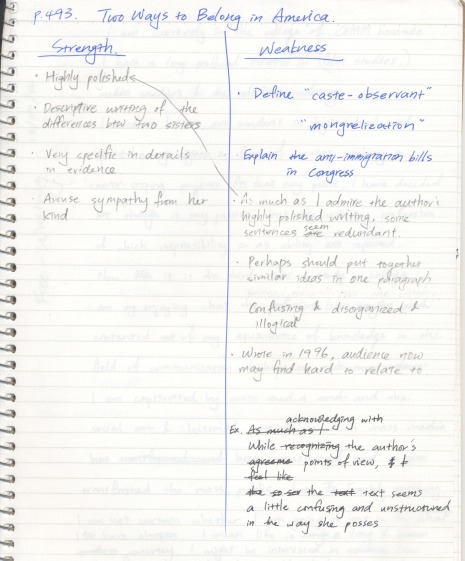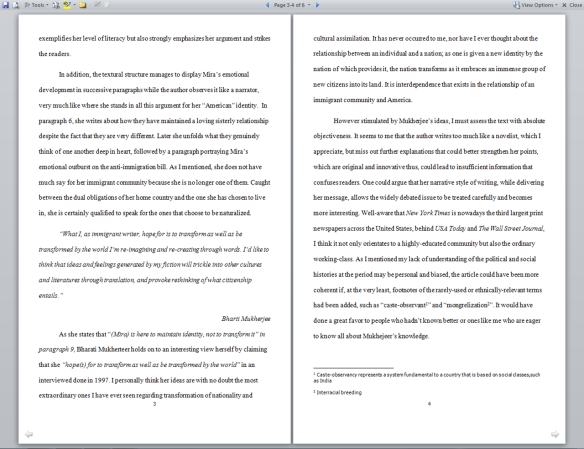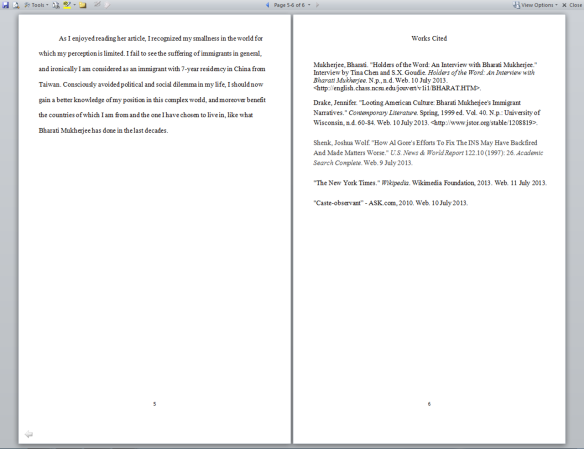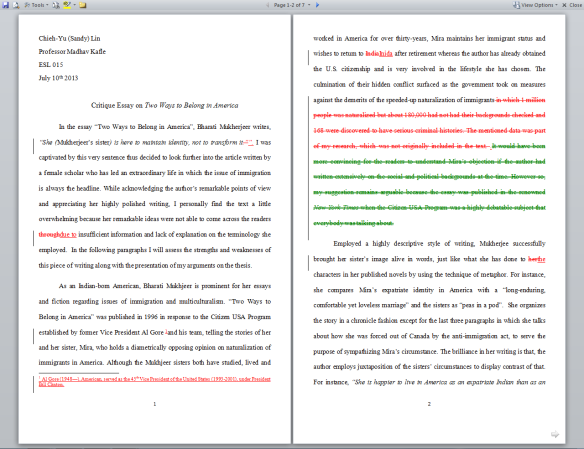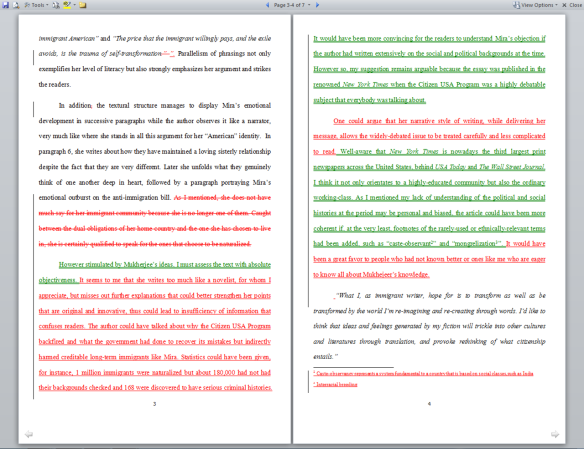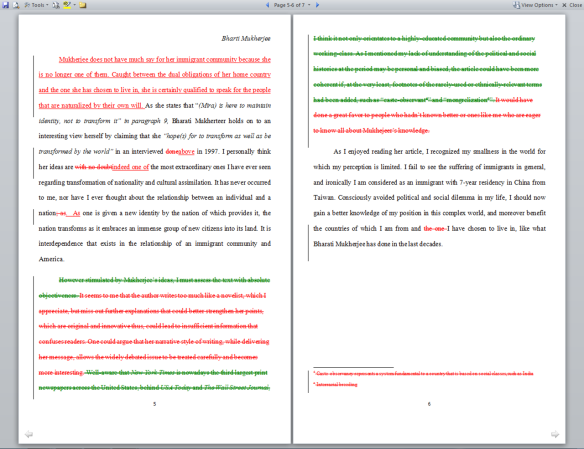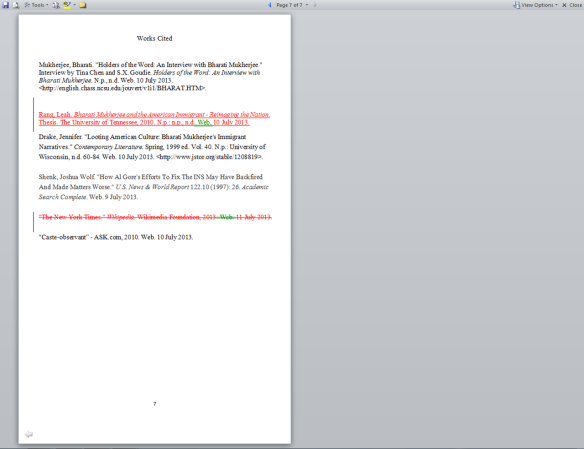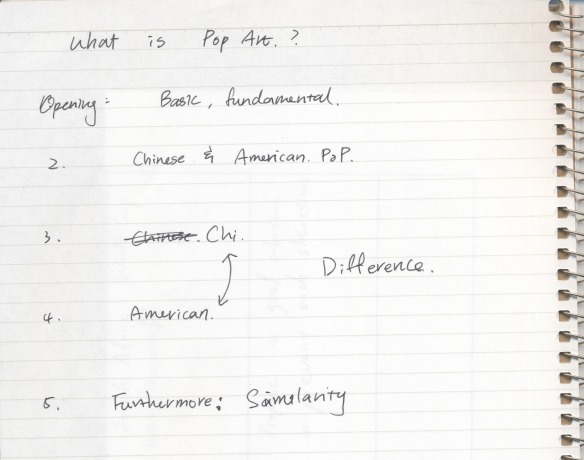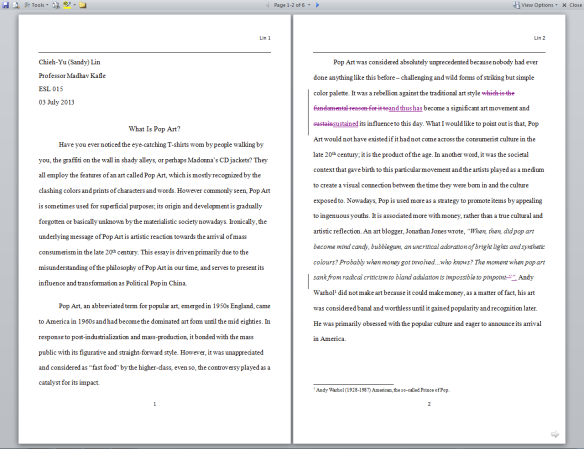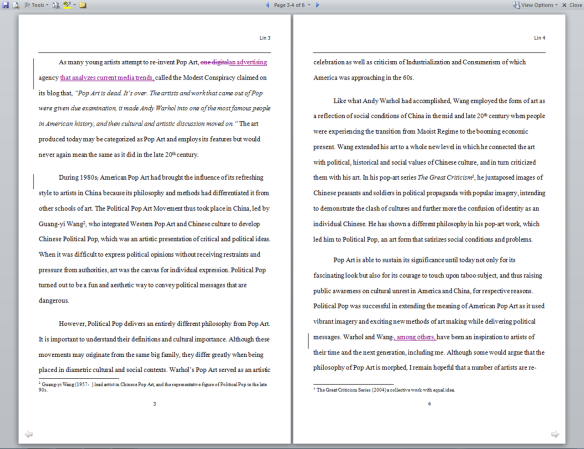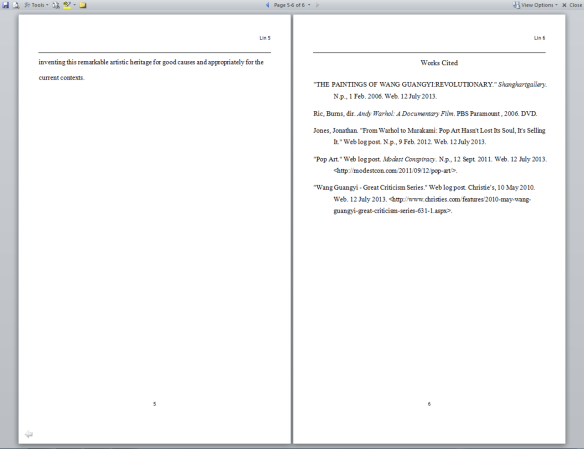Among the three major essay assignments I am most proud of my second one, which is the critique essay. It assesses the strengths and weaknesses in an article called Two Ways to Belong in America by Bharati Mukherjeer, who through out the course of writing became my inspiration, my new role model. I have revised the essay twice, respectively from Sieun and Madhav’s assistance. I made a drastic change to my final draft in terms of content structure, the way I organized my paragraphs. It seems like I have too much to say and there’s a lack of transition between the paragraphs, weakening the coherence of my writing. However, I had enjoyed the process of evaluating an article and sought for its merits and demerits, which helped me come to a realization of what to avoid when writing a similar form of essay like Mukherjeer’s. In addition I was extremely confused when I first glanced at the article which was published in 1996. And what baffled me the most was the article’s topic: immigration and American laws associated to it. I am definitely not familiar with happened 17 years go regarding V.P. Al Gore and his decision on immigration reform, so I was inevitably in need for some research. However, what came as a burden had become highlights of my writing. It is exactly due to my effort of learning the history behind the article allowed me write with confidence and sympathy. Without all this work, I would be intimidated by the article and unable to assess it. Moreover, I have learned to think outside of the box on the issue of immigration which is crucial to me because I have had a similar experience yet struggled to identify it.
First Draft
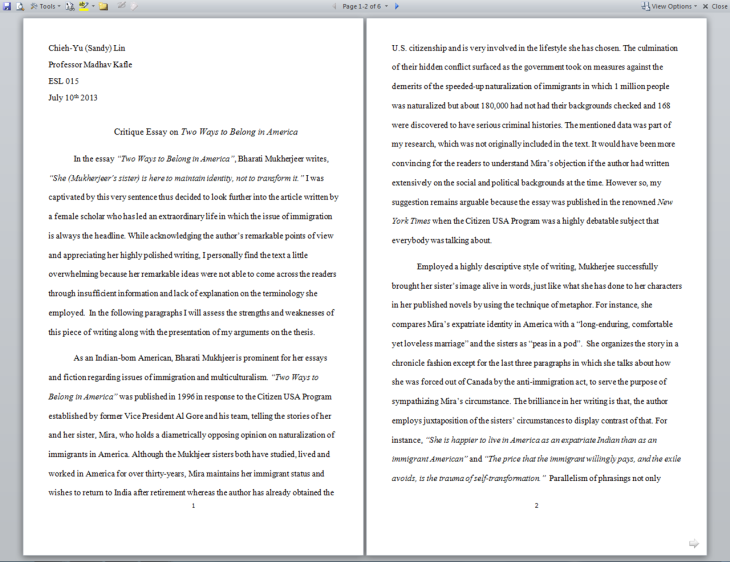
Critique Essay Peer Review From Sieun
Dear. Sandy
As I noticed, your Eng is really perfect as both a writer and speaker, you are not born here though.
since I’m not a professional about writing, I’m not sure if my feedback is helpful or not.
anyway, you are snailed at the first paragraph by putting your goal of this essay,but I cannot figure out what your side is. Is it focusing on strengths or weaknesses?
and another problem is summary, I think. you’ve already summarized this article in the second paragraph.
but right after the summary, the weakness just pop out, so I think you’d better make the second paragraph just to have only summary of the article.
I think the strengths and weakness are mixed up in your writing. maybe, according to the flow of the story, you intended to write this essay.
however, it makes me confused a little bit.
however, I was impressed about your research, sophistcated sentences and contents.
oh, and you cannot use the source from Wikipedia. At the first essay, I used some source from wikipedia, and the professor said it is not possible to use it b/c the source is not considered as not credible.
I don’t know my review is exactly pointing out what you are doing but you’ve done a great job :D! good luck to u!
Best, Sieun
Comparing Final Draft with Revised Version
Chieh-Yu (Sandy) Lin
Professor Madhav Kafle
ESL 015
July 10th 2013
Critique Essay on Two Ways to Belong in America
In the essay “Two Ways to Belong in America”, Bharati Mukherjee writes, “She (Mukherjee’s sister) is here to maintain identity, not to transform it.” I was captivated by this very sentence thus decided to look further into the article written by a female scholar who has led an extraordinary life in which the issue of immigration is always the headline. While acknowledging the author’s remarkable points of view and appreciating her highly polished writing, I personally find the text a little overwhelming because her remarkable ideas were not able to come across the readers due to insufficient information and lack of explanation on the terminology she employed. In the following paragraphs I will assess the strengths and weaknesses of this piece of writing along with the presentation of my arguments on the thesis.
As an Indian-born American, Bharati Mukhjee is prominent for her essays and fiction regarding issues of immigration and multiculturalism. “Two Ways to Belong in America” was published in 1996 in response to the Citizen USA Program established by former Vice President Al Gore and his team, telling the stories of her and her sister, Mira, who holds a diametrically opposing opinion on naturalization of immigrants in America. Although the Mukhjee sisters both have studied, lived and worked in America for over thirty-years, Mira maintains her immigrant status and wishes to return to India after retirement whereas the author has already obtained the U.S. citizenship and is very involved in the lifestyle she has chosen. The culmination of their hidden conflict surfaced as the government took on measures against the demerits of the speeded-up naturalization of immigrants.
Employing a highly descriptive style of writing, Mukherjee successfully brought her sister’s image alive in words, just like what she has done to the characters in her published novels by using the technique of metaphor. For instance, she compares Mira’s expatriate identity in America with a “long-enduring, comfortable yet loveless marriage” and the sisters as “peas in a pod”. She organizes the story in a chronicle fashion except for the last three paragraphs in which she talks about how she was forced out of Canada by the anti-immigration act, to serve the purpose of sympathizing Mira’s circumstance. The brilliance in her writing is that, the author employs juxtaposition of the sisters’ circumstances to display contrast of that. For instance, “She is happier to live in America as an expatriate Indian than as an immigrant American” and “The price that the immigrant willingly pays, and the exile avoids, is the trauma of self-transformation”. Parallelism of phrasings not only exemplifies her level of literacy but also strongly emphasizes her argument and strikes the readers.
In addition the essay structure manages to display Mira’s emotional development in successive paragraphs while the author observes it like a narrator, very much like where she stands in all this argument for her “American” identity. In paragraph 6, she writes about how they have maintained a loving sisterly relationship despite the fact that they are very different. Later she unfolds what they genuinely think of one another deep in heart, followed by a paragraph portraying Mira’s emotional outburst on the anti-immigration bill.
However stimulated by Mukherjee’s ideas, I must be objective while assessing the text. It seems to me that she writes too much like a novelist, for whom I appreciate, but misses out further explanations that could better strengthen her points that are original and innovative, thus could lead to insufficiency of information that confuses readers. The author could have talked about why the Citizen USA Program backfired and what the government had done to recover its mistakes but indirectly harmed creditable long-term immigrants like Mira. Statistics could have been given, for instance, 1 million immigrants were naturalized but about 180,000 had not had their backgrounds checked and 168 were discovered to have serious criminal histories. It would have been more convincing for the readers to understand Mira’s objection if the author had written extensively on the social and political backgrounds at the time. However, my suggestion remains arguable because the essay was published in the renowned New York Times when the Citizen USA Program was a highly debatable subject that everybody was talking about.
One could argue that her narrative style of writing, while delivering her message, allows the widely-debated issue to be treated carefully and less complicated to read. Well-aware that New York Times is nowadays the third largest print newspapers across the United States, behind USA Today and The Wall Street Journal, I think it not only orientates to a highly-educated community but also the ordinary working-class. As I mentioned my lack of understanding of the political and social histories at the period may be personal and biased, the article could have been more coherent if, at the very least, footnotes of the rarely-used or ethnically-relevant terms had been added, such as “caste-observant ” and “mongrelization ”. It would have been a great favor to people who had not known better or ones like me who are eager to know all about Mukhejee’s knowledge.
Mukherjee does not have much say for her immigrant community because she is no longer one of them. Caught between the dual obligations of her home country and the one she has chosen to live in, she is certainly qualified to speak for the people that are naturalized by their own will. As she states that “(Mira) is here to maintain identity, not to transform it” in paragraph 9, Bharati Mukherjee holds on to an interesting view herself by claiming that she “hope(s) for to transform as well as be transformed by the world” in an interviewed in 1997:
What I, as immigrant writer, hope for is to transform as well as be transformed by the world I‘m re-imagining and re-creating through words. I‘d like to think that ideas and feelings generated by my fiction will trickle into other cultures and literatures through translation, and provoke rethinking of what citizenship entails.
I personally think her ideas are indeed one of the most extraordinary ones I have ever seen regarding transformation of nationality and cultural assimilation. It has never occurred to me, nor have I ever thought about the relationship between an individual and a nation. As one is given a new identity by the nation of which provides it, the nation transforms as it embraces an immense group of new citizens into its land. It is interdependence that exists in the relationship of an immigrant community and America.
As I enjoyed reading her article, I recognized my smallness in the world for which my perception is limited. I fail to see the suffering of immigrants in general, and ironically I am considered as an immigrant with 7-year residency in China from Taiwan. Consciously avoided political and social dilemma in my life, I should now gain a better knowledge of my position in this complex world, and moreover benefit the countries of which I am from and I have chosen to live in, like what Bharati Mukherjee has done in the last decades.
Works Cited
Mukherjee, Bharati. “Holders of the Word: An Interview with Bharati Mukherjee.” Interview by Tina Chen and S.X. Goudie. Holders of the Word: An Interview with Bharati Mukherjee. N.p., n.d. Web. 10 July 2013. <http://english.chass.ncsu.edu/jouvert/v1i1/BHARAT.HTM>.
Rang, Leah. Bharati Mukherjee and the American Immigrant – Reimaging the Nation. Thesis. The University of Tennessee, 2010. N.p.: n.p., n.d. Web. 10 July 2013.
Drake, Jennifer. “Looting American Culture: Bharati Mukherjee’s Immigrant Narratives.” Contemporary Literature. Spring, 1999 ed. Vol. 40. N.p.: University of Wisconsin, n.d. 60-84. Web. 10 July 2013. <http://www.jstor.org/stable/1208819>.
Shenk, Joshua Wolf. “How Al Gore’s Efforts To Fix The INS May Have Backfired And Made Matters Worse.” U.S. News & World Report 122.10 (1997): 26. Academic Search Complete. Web. 9 July 2013.

